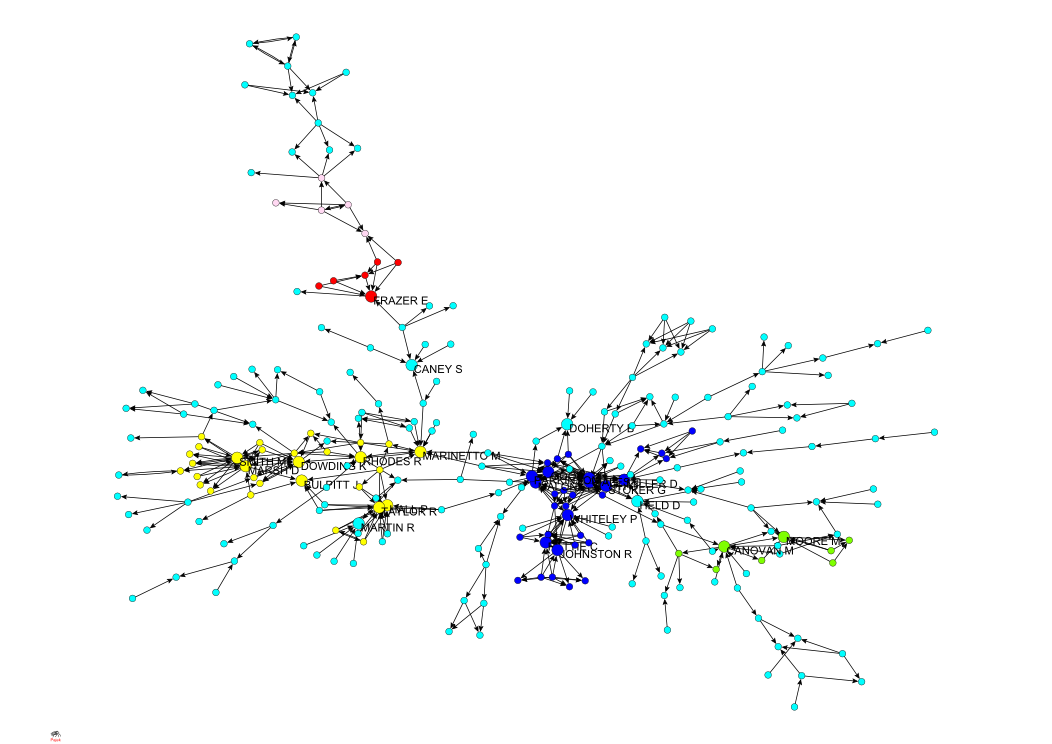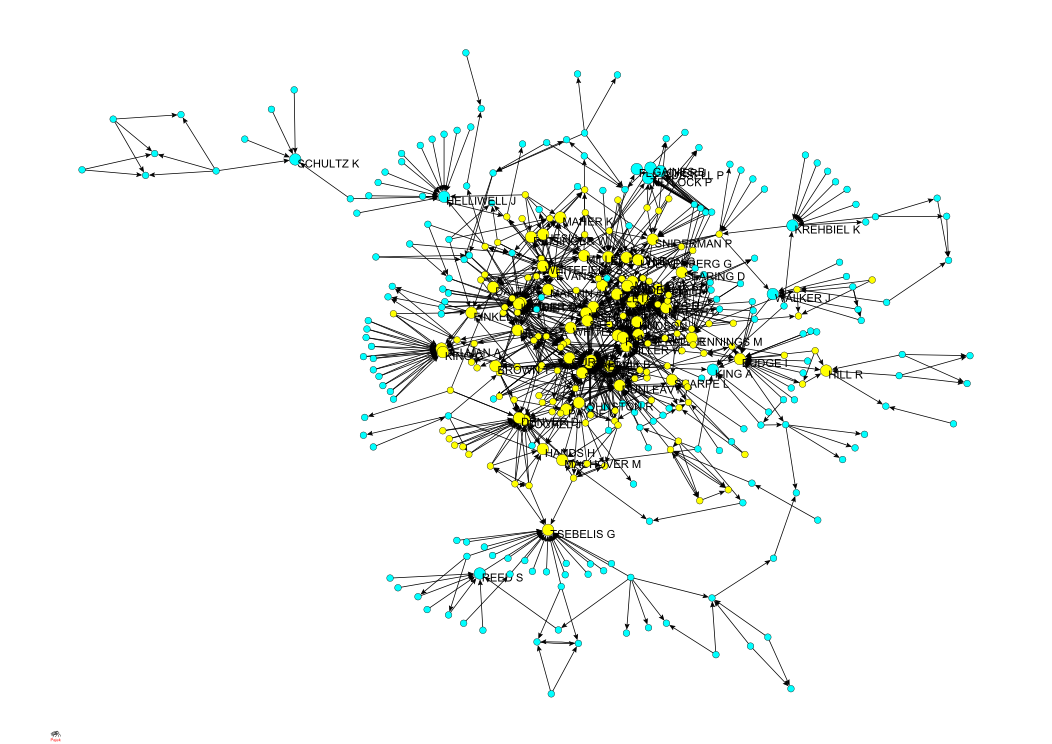Citations in British Political Science (BJPS and PS)
Patterns of Citation in British Political Science: Political Studies
In PS, 359 authors are part of the citation network. Mutual citation is even rarer than in PVS (there are only 17 dyads). Unlike in PVS, there is no large component of authors who mutually cite each other. Again, mutual citations within the journal seem to be largely due to joint work in the past. Splitting the network in weak components yields a single large component of 250 authors. Within this component, 40 per cent of the authors receive no citations, 22 per cent receive a single citation, and 24 per cent receive between 2 and 4 citations. The remaining 10 per cent are cited by up to 15 different authors, so like in Germany, there exists a clear hierarchy within the journal with Smith, Whiteley, Pattie, Marinetto, Hall, and Taylor at the top.

To identify subfields, we searched again for triangles and used Pajek's island algorithm. As it turns out, there are two dense regions, each of which involves about 30 authors. The first one (with focal authors such as Dowding, Marsh, Rhodes, and Marinetto) is largely concerned with rational choice approaches to governance, institutions, and policies. The second cluster is particularly interesting because it involves authors who are primarily interested in empirical political sociology (e.g. Whiteley, Johnston and Pattie) as well as political theorists interested in empirical political theory. Broad concepts such as social capital, deliberation and democracy apparently help to bridge the gap between theory and practice. On the other other hand, at least within the confines of PS, there are very few links between the two large clusters. Two smaller clusters in the upper left corner of the figure should probably be merged since the both consist of authors with an interest in electoral institutions. They appear as separate because like many other regions of the graph, they are not particularly dense. Finally, there is one smaller cluster (in the lower right corner of the graph) of eight authors interested in liberal political theory, with Canovan and Moore at its centre. Substantively, this clustering seems to make a lot of sense.
Patterns of Citations in British Political Science: British Journal of Political Science
Turning to BJPS we find that owing to the relatively high rate of internal citations, a large number (422) of the journal's authors are part of the journals citation network. Again, mutual citation is rare (26 instances), and there are no large components of authors who cite each other within the journal. Like with the other journals, joint articles which are referenced by two or more of the original collaborators in later work are a major source of mutual citations. 368 authors (87 per cent) belong to a single large component. Of these, 52 per cent are not cited by anyone else within the journal, 12 per cent receive a single citation, 19 per cent receive between 2 and 4 citations, whereas 17 per cent have between 5 and 38 citations under their belt. In terms of their indegree, Alt, Crewe, Warren Miller, Kiewit, Kinder, and Sarlvik are the most central contributors to the journal.

Applying the now familiar census of 3-rings and the island algorithm, we find one large core area with a very high density that encompasses about 45 per cent of the authors. The contrast between our findings for the two other journals and the existence of a single large and very dense centre in BJPS (that encompasses scholars from various subfields such as political sociology, rational choice theory and political theory is highly significant in our view. Moreover, it is interesting to note that A handful of highly cited authors (Helliwell, Krehbiel) are outside this cluster, and that at least three prominent American scholars (Gelman, Gary King, and Tsebelis) have published articles that are highly cited in the journal (and elsewhere) but make no references to work that was previously published in BJPS, bringing them to the brink of the cluster.
Patterns of Citations in Elite British Political Science Journals
ike with co-publications, given the stature of PS and BJPS it makes sense to combine our data on the two journals to get an idea about the structure of (elite) political science in the UK. This merging yields a network of 847 authors. Within this new network, we find a much larger (68) number of mutual citations than we had identified on a per journal base. What is more, a rather large component of 24 authors who are connected by mutual citations in the UK's two top political science journals emerges. This sub-network is rather centralised and focused on Sanders, who enjoys mutual citation relations with 10 other authors. Again, joint work in the past plays a role here.
Turning back to the bigger picture, the vast majority (87 per cent) of all authors belong to one large component. Within the component, 47 per cent of all authors are not cited at all, 15 per cent receive a single citation, whereas 22 per cent receive between 2 and 4 citations. The remaining 16 per cent are cited by up to 51 other authors, with Alt, Crewe, Warren Miller, and Sarlvik (who all cite each others' work) and Marsh at the top. Applying the 3-ring census and the island algorithm, we find two islands. One consists of those 8 liberal theorists grouped around Canover and Moore whom we already have encountered in the analysis of PS. The other - less concentrated on a journal - cluster encompasses 299 authors who have some claim to form the core of British political science.